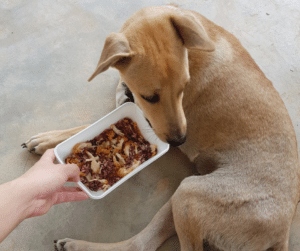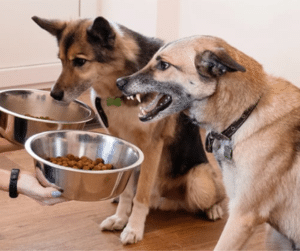The Hidden Costs of Free Feeding Your Dog And How It Can Effect Your Dog Training
The choice between free feeding and scheduled feeding is a pivotal decision for dog owners, impacting not just convenience but the health, behaviour, training and lifespan of their canine companions. While free feeding—the practice of leaving food out for dogs to eat anytime—might seem benign, it carries significant risks that warrant a closer examination.
Understanding Free Feeding and Its Widespread Appeal
Free feeding is often chosen for its perceived simplicity: fill a bowl with dog food and let the dog eat whenever it chooses. This method appeals to owners who value convenience and believe it mimics a dog’s natural grazing habits. However, this perception overlooks the domestic dog’s nutritional needs and social structure, which have evolved significantly from their wild ancestors. Unlike wild canines that may eat sporadically based on prey availability, domestic dogs thrive on routine and consistency, which free feeding does not provide.
The Perils of Unregulated Eating
 The lack of portion control inherent in free feeding can lead to overeating and weight gain. Obesity in dogs is not merely an aesthetic concern; it’s a health crisis. Overweight dogs face a higher risk of diabetes, cardiovascular disease, and joint problems, such as arthritis. These conditions not only diminish a dog’s quality of life but can also lead to costly veterinary treatments and a shortened lifespan. The challenge extends beyond monitoring food intake; it’s about understanding and managing a dog’s nutritional needs to ensure they receive a balanced diet tailored to their age, breed, and activity level.
The lack of portion control inherent in free feeding can lead to overeating and weight gain. Obesity in dogs is not merely an aesthetic concern; it’s a health crisis. Overweight dogs face a higher risk of diabetes, cardiovascular disease, and joint problems, such as arthritis. These conditions not only diminish a dog’s quality of life but can also lead to costly veterinary treatments and a shortened lifespan. The challenge extends beyond monitoring food intake; it’s about understanding and managing a dog’s nutritional needs to ensure they receive a balanced diet tailored to their age, breed, and activity level.
Disrupting House Training and Routine
A structured routine is crucial for effective house training, especially for puppies and newly adopted dogs. Free feeding disrupts this structure, making it difficult for owners to predict when their dog needs to relieve themselves. This unpredictability can result in more accidents within the home and slow the progress of house training. Establishing set meal times creates a predictable routine, helping dogs understand when it’s time to eat, play, and go outside, which in turn supports their overall behavioural development.
Fostering Picky Eating Habits
 Constant access to food can lead to selective eating habits. Dogs may become less interested in their meals, knowing that food is always available. This behaviour can lead to nutritional imbalances if dogs favour certain types of food over others, potentially missing out on essential nutrients. Moreover, picky eating can complicate feeding routines, making it challenging for owners to ensure their dogs are receiving a balanced diet.
Constant access to food can lead to selective eating habits. Dogs may become less interested in their meals, knowing that food is always available. This behaviour can lead to nutritional imbalances if dogs favour certain types of food over others, potentially missing out on essential nutrients. Moreover, picky eating can complicate feeding routines, making it challenging for owners to ensure their dogs are receiving a balanced diet.
The Impact on Training and Behaviour
Diminishing Food as a Training Tool
In the realm of dog training, the use of food as a reward is a time-honoured and scientifically supported method to encourage desirable behaviours. Food rewards leverage a dog’s natural motivation for food to reinforce actions that owners want to encourage, from basic obedience commands like “sit” and “stay” to more complex behaviours in advanced training scenarios. However, the efficacy of this method is significantly compromised by free feeding, for several reasons:
Reduced Food Motivation
 Dogs that have constant access to food naturally exhibit a lower motivation to work for food rewards. In a free-feeding scenario, the omnipresence of food diminishes its value as a special or desirable item. This reduced food motivation can lead to apathy towards training exercises that rely on food rewards, making it challenging for trainers and owners to capture the dog’s interest and maintain their engagement in training sessions.
Dogs that have constant access to food naturally exhibit a lower motivation to work for food rewards. In a free-feeding scenario, the omnipresence of food diminishes its value as a special or desirable item. This reduced food motivation can lead to apathy towards training exercises that rely on food rewards, making it challenging for trainers and owners to capture the dog’s interest and maintain their engagement in training sessions.
Impact on Learning and Behaviour Modification
The cornerstone of effective dog training is the ability to influence behaviour through reinforcement—rewarding the dog for correct responses to encourage those behaviours to be repeated. When food loses its appeal due to free feeding, trainers lose a vital tool in their arsenal for positive reinforcement. This can slow the learning process, making it more difficult to instil new behaviours or modify existing ones. Dogs may become less responsive to commands and cues, and training sessions may become less productive and more frustrating for both the dog and the trainer.
Challenges in Maintaining Training Consistency
 Consistency is key in dog training, with repeated, reinforced practice being essential for dogs to learn and internalise desired behaviours. However, when food is not a compelling motivator, achieving this consistency becomes a struggle. Trainers and owners may find it difficult to practice behaviours sufficiently or may need to resort to less effective or less desirable forms of motivation, which can complicate or delay training progress.
Consistency is key in dog training, with repeated, reinforced practice being essential for dogs to learn and internalise desired behaviours. However, when food is not a compelling motivator, achieving this consistency becomes a struggle. Trainers and owners may find it difficult to practice behaviours sufficiently or may need to resort to less effective or less desirable forms of motivation, which can complicate or delay training progress.
Alternative Strategies and Solutions
To counteract the diminishing effect of food as a training tool caused by free feeding, transitioning to scheduled feeding can restore food’s value as a potent reward. By offering food only at specific times and removing it afterwards, dogs learn to appreciate meal times and, by extension, are more likely to be motivated by food rewards during training. This heightened interest in food allows trainers to effectively use food rewards to shape behaviours, reinforce commands, and encourage engagement.
Additionally, trainers can employ a variety of food-based rewards to maintain interest and motivation. Using high-value treats—foods that are especially appealing to the dog and are reserved solely for training purposes—can further enhance the effectiveness of food as a reward. These treats can vary in flavour, texture, and smell to cater to the dog’s preferences, ensuring that the dog remains eager to earn these special rewards.
Contributing to Behavioural Issues
Free feeding can inadvertently contribute to behavioural issues such as food aggression and resource guarding. When food is constantly available, some dogs may feel the need to protect their food source, leading to aggressive behaviours towards humans and other pets. These behaviours can be challenging to correct and may pose safety risks.
Health Risks Beyond Obesity
The Link Between Free Feeding and Hip Dysplasia

The Challenge of Monitoring Health
Scheduled feeding enables owners to closely monitor their dog’s appetite and dietary habits, which are crucial indicators of health. A sudden loss of appetite can signal underlying health issues, prompting timely veterinary intervention. Free feeding makes it difficult to notice these changes, potentially delaying the diagnosis and treatment of health problems.
Rethinking Free Feeding: The Case for Scheduled Feeding
Transitioning to scheduled feeding offers numerous benefits, including regulated food intake, support for routine and training, and the prevention of obesity and related health issues. This structured approach fosters a healthier, happier life for dogs, enhancing their well-being and the bond they share with their owners.
FAQs
Conclusion: Prioritising Your Dog’s Health and Happiness
The shift from free feeding to a structured feeding schedule is a step towards prioritising your dog’s health and happiness. Understanding the negative effects of free feeding empowers dog owners to make informed decisions that enhance their pets’ well-being and pave the way for a fulfilling life together.
Scheduled feeding not only addresses the immediate concerns associated with free feeding but also lays the foundation for a thriving relationship between dogs and their owners, marked by mutual respect, understanding, and care.
- Name: K9 Principles
- Address: Haldimand County, Greater Hamilton Area, Burlington and Most of Norfolk County
- Phone: 289 880-3382
- Email: k9principlesinc@gmail.com
- Website: www.k9principles.ca



